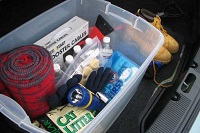
Do you have a winter safety kit in your car? It’s a safe bet that most of you reading this probably don’t; they are an often-overlooked piece of the overall safety puzzle. After all, we have supercomputers in our pockets, and our cars are almost as smart at this point. Why would outdoor safety and survival be a concern for a modern person?
Remove the electricity supplied by your car’s battery from the equation, however, and it’s a completely different story. Throw in unknown roads, changing weather conditions, and spotty cell service, and that trip to grandma’s house just became a legitimate threat to your life and the lives of everyone traveling with you.
A good winter safety kit should have everything you’ll need to keep you sheltered, warm, and fed while you wait for rescue. Whether you hit an ice patch and go off the road, run out of gas, or blow a tire, your winter safety kit may become your lifeline until help arrives.
Numerous online resources will have the information you’ll need to make a good one, but at a minimum you should have some emergency blankets, chemical heat packs, granola or energy bars, and a flashlight with fresh batteries. Flares and other stationary road markings are also a good idea.
Of course, in many cases, knowing your winter travel limits and keeping your vehicle in proper working order can help you avoid the situation entirely. Check and test all your lights and inspect your tires for proper tread depth. Check ahead and know the weather you’ll encounter on your trip and ask yourself if you’re able to safely navigate through those kinds of conditions. And, for those with four wheel drive, understand that it has no affect on your ability to stop once you’re moving.
For longer trips, whether by plane, train, or automobile, make sure you take time to move around at regular intervals – even if that means pulling the car off the road. Blood clots are a real concern with long-term travel and they can be lethal. A blood clot that forms in your leg, known as a deep vein thrombosis or DVT, can break loose and travel to your brain, lungs, and heart.
Travel is hard enough on the body, but winter travel’s additional concerns often go overlooked. As modern humans, we’re almost entirely dependent on the technology we’ve created to keep us safe and warm. When those things are suddenly taken away and we’re left with the clothes on our back, it is those who have prepared for the situation that will weather the storm.
